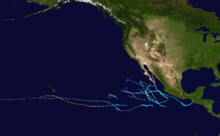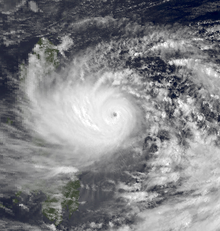Portal:Tropical cyclones
The Tropical Cyclones Portal

A tropical cyclone is a storm system characterized by a large low-pressure center, a closed low-level circulation and a spiral arrangement of numerous thunderstorms that produce strong winds and heavy rainfall. Tropical cyclones feed on the heat released when moist air rises, resulting in condensation of water vapor contained in the moist air. They are fueled by a different heat mechanism than other cyclonic windstorms such as Nor'easters, European windstorms and polar lows, leading to their classification as "warm core" storm systems. Most tropical cyclones originate in the doldrums, approximately ten degrees from the Equator.
The term "tropical" refers to both the geographic origin of these systems, which form almost exclusively in tropical regions of the globe, as well as to their formation in maritime tropical air masses. The term "cyclone" refers to such storms' cyclonic nature, with anticlockwise rotation in the Northern Hemisphere and clockwise rotation in the Southern Hemisphere. Depending on its location and intensity, a tropical cyclone may be referred to by names such as "hurricane", "typhoon", "tropical storm", "cyclonic storm", "tropical depression" or simply "cyclone".
Types of cyclone: 1. A "Typhoon" is a tropical cyclone located in the North-west Pacific Ocean which has the most cyclonic activity and storms occur year-round. 2. A "Hurricane" is also a tropical cyclone located at the North Atlantic Ocean or North-east Pacific Ocean which have an average storm activity and storms typically form between May 15 and November 30. 3. A "Cyclone" is a tropical cyclone that occurs in the South Pacific and Indian Oceans.
Selected named cyclone -
Typhoon Dot, known in the Philippines as Typhoon Saling, was the strongest storm of the 1985 season. Dot originated from a small area of thunderstorm activity in early to mid October. The system was first classified on October 11, and steadily intensified over the next few days. Dot attained typhoon strength on October 15, and subsequently entered a period of explosive deepening, which was not anticipated by forecasters. The next day the intensification rate slowed, but that evening, Dot attained its maximum intensify. A steady weakening trend began on October 17, though the system maintained typhoon intensity through the passage of the Philippines. After entering the South China Sea late on October 18, Dot briefly re-intensified, only to weaken as it approached Vietnam. On October 21, Dot struck Vietnam while still a typhoon, but dissipated the next day over the high terrain of the nation.
Although damage across the Philippines was less than initially expected, the typhoon lashed the nation with heavy rains. Province of Nueva Ecija suffered the worst effects from Dot. There, 500,000 acres (200,000 ha) of crops and 90% of all buildings were damaged. In Cabanatuan, 2,500 homes and 90% of structures were destroyed. Overall, 42 towns were flooded, forcing a total of 125,000 people to flee their homes, 35,000 of which were homeless. Furthermore, 52,933 houses were leveled while an additional 200,450 were damaged. Nationwide, 24 were hurt. While tracking through the South China Sea, Dot passed through Hainan Island. There, two casualties occurred while 34 others suffered injuries. Across the island, over 2,300 dwellings were destroyed. In all, Dot was responsible for 90 deaths and $104.9 million (1985 USD) in damage. (Full article...)Selected article -

The effects of tropical cyclones include heavy rain, strong wind, large storm surges near landfall, and tornadoes. The destruction from a tropical cyclone, such as a hurricane or tropical storm, depends mainly on its intensity, its size, and its location. Tropical cyclones remove forest canopy as well as change the landscape near coastal areas, by moving and reshaping sand dunes and causing extensive erosion along the coast. Even well inland, heavy rainfall can lead to landslides in mountainous areas. Their effects can be sensed over time by studying the concentration of the Oxygen-18 isotope within caves.
After the cyclone has occurred, devastation often continues. Fallen trees can block roads and delay rescues, with medical supplies, or slow the repairs to electrical lines, telephone towers or water pipes, which could put other lives at risk for days or months. Stagnant water can cause the spread of disease, and transportation or communication infrastructure may have been destroyed, hampering clean-up and rescue efforts. Nearly 2 million people have died globally due to tropical cyclones. Despite their devastating effects, tropical cyclones are also beneficial, by potentially bringing rain to dry areas and moving heat from the tropics poleward. Out at sea, ships take advantage of their known characteristics by navigating through their weaker, western half. (Full article...)Selected image -
Selected season -

The 2007 Pacific hurricane season was a well below-average Pacific hurricane season, featuring only one major hurricane. The season officially started on May 15 in the eastern Pacific and on June 1 in the central Pacific, and ended on November 30; these dates conventionally delimit the period during which most tropical cyclones form in the region. The first tropical cyclone of the season, Alvin, developed on May 27, while the final system of the year, Kiko, dissipated on October 23. Due to unusually strong wind shear, activity fell short of the long-term average, with a total of 11 named storms, 4 hurricanes, and 1 major hurricane. At the time, 2007 featured the second-lowest value of the Accumulated cyclone energy (ACE) index since reliable records began in 1971. Two tropical cyclones – Cosme and Flossie – crossed into the central Pacific basin during the year, activity below the average of 4 to 5 systems.
Impact during the season was relatively minimal. In early June, Tropical Storm Barbara moved ashore just northwest of the Mexico–Guatemala border, causing $55 million (2007 USD) in damage and 4 deaths. In late July, Cosme passed south of the island of Hawaii as a weakening tropical depression; light rain and increased surf resulted. A few days later, Dalila passed offshore the coastline of southwestern Mexico, killing 11 and causing minimal damage. Hurricane Flossie followed a similar track to Cosme in mid-August, producing gusty winds and light precipitation in Hawaii. Hurricane Henriette in early September produced torrential rainfall in southwestern Mexico, killing 6 and causing $25 million in damage. Baja California received moderate rains from Hurricane Ivo in mid-September, though no damage nor fatalities were reported. In mid-October, Tropical Storm Kiko passed just offshore the coastline of southwestern Mexico. Though no deaths were reported on the Mexico mainland, the storm capsized a ship with 30 people on board, 15 of whom were recovered dead, and 9 of whom were reported missing. Overall, the season ended with $80 million in damage and 49 deaths. (Full article...)Related portals
Currently active tropical cyclones

Italicized basins are unofficial.
- North Atlantic (2024)
- No active systems
- East and Central Pacific (2024)
- No active systems
- West Pacific (2024)
- No active systems
- North Indian Ocean (2024)
- No active systems
- Mediterranean (2023–24)
- No active systems
- South-West Indian Ocean (2023–24)
- No active systems
- Australian region (2023–24)
- No active systems
- South Pacific (2023–24)
- No active systems
- South Atlantic (2023–24)
- No active systems
Last updated: 21:54, 8 May 2024 (UTC)
Tropical cyclone anniversaries

May 15
- 1982 - Tropical Storm Claudia (pictured) affects the Solomon Islands as a weak cyclone.
- 1996 - Typhoon Bart reaches Category 4 typhoon intensity just northeast of Luzon.
- 2024 - The 2024 East Pacific hurricane season officially begins.

May 16
- 1989 - Typhoon Brenda (pictured) passed over the Philippines, causing torrential flooding that killed at least 140 people.
- 2004 - Typhoon Nida reaches peak intensity as an intense typhoon, off the coast of eastern Philippines, causing minor damage.
- 2015 - Typhoon Dolphin reaches peak intensity, impacting the Mariana Islands with $14 million in damages.

May 17
- 1951 - Hurricane Able reached hurricane strength over The Bahamas, being one of the earliest pre-season hurricanes recorded.
- 2006 - Typhoon Chanchu (pictured) makes landfall over in Shantou, China, causing about ¥7 billion (US$872 million) in damage in the country.
- 2021 - Cyclone Tauktae struck Gujarat and affected much of western India, killing 174 people and causing US$2 billion in damage.
Did you know…




- …that the Joint Typhoon Warning Center considers that Typhoon Vera (pictured) of 1986 is actually two distinct systems, formed from two separated low-level circulations?
- …that Hurricane Agatha (pictured) was the strongest Pacific hurricane to make landfall in Mexico in May since records began in 1949?
- …that Cyclone Raquel (track pictured) travelled between the Australian and South Pacific basins between the 2014–15 and 2015–16 seasons, spanning both seasons in both basins?
- …that Cyclone Amphan (pictured) in 2020 was the first storm to be classified as a Super Cyclonic Storm in the Bay of Bengal since 1999?
General images -

The 1982 Atlantic hurricane season was an event in the annual tropical cyclone season in the north Atlantic Ocean. It was an inactive Atlantic hurricane season, during which only five tropical cyclones formed. The season officially began on June 1, 1982 and ended November 30, 1982. These dates, adopted by convention, historically describe the period in each year when most systems form. this year, however, most tropical activity was constrained to the month of September.
This season produced eight tropical depressions, of which five became named storms; two attained hurricane status, of which one became a major hurricane, a storm that ranks as a Category 3 or higher on the Saffir–Simpson scale. Hurricane Alberto, the season's first named storm, was one of four storms on record to attain hurricane status in the Gulf of Mexico that not make landfall. The other three were Laurie of 1969, Henri of 1979, and Jeanne of 1980. Nonetheless, rains from Alberto caused severe flooding, which killed 23 people in Cuba. The season's only major hurricane, Debby, reached peak intensity as a weak Category 4 over the open waters of the Atlantic. Tropical Storm Ernesto, the last storm of the season, peaked in intensity on October 2 just below hurricane strength. It then dissipated the next day, 58 days before the official end of the season. (Full article...)Topics
Subcategories
Related WikiProjects
WikiProject Tropical cyclones is the central point of coordination for Wikipedia's coverage of tropical cyclones. Feel free to help!
WikiProject Weather is the main center point of coordination for Wikipedia's coverage of meteorology in general, and the parent project of WikiProject Tropical cyclones. Three other branches of WikiProject Weather in particular share significant overlaps with WikiProject Tropical cyclones:
- The Non-tropical storms task force coordinates most of Wikipedia's coverage on extratropical cyclones, which tropical cyclones often transition into near the end of their lifespan.
- The Floods task force takes on the scope of flooding events all over the world, with rainfall from tropical cyclones a significant factor in many of them.
- WikiProject Severe weather documents the effects of extreme weather such as tornadoes, which landfalling tropical cyclones can produce.
Things you can do
 |
Here are some tasks awaiting attention:
|
Wikimedia
The following Wikimedia Foundation sister projects provide more on this subject:
-
Commons
Free media repository -
Wikibooks
Free textbooks and manuals -
Wikidata
Free knowledge base -
Wikinews
Free-content news -
Wikiquote
Collection of quotations -
Wikisource
Free-content library -
Wikiversity
Free learning tools -
Wikivoyage
Free travel guide -
Wiktionary
Dictionary and thesaurus
























































